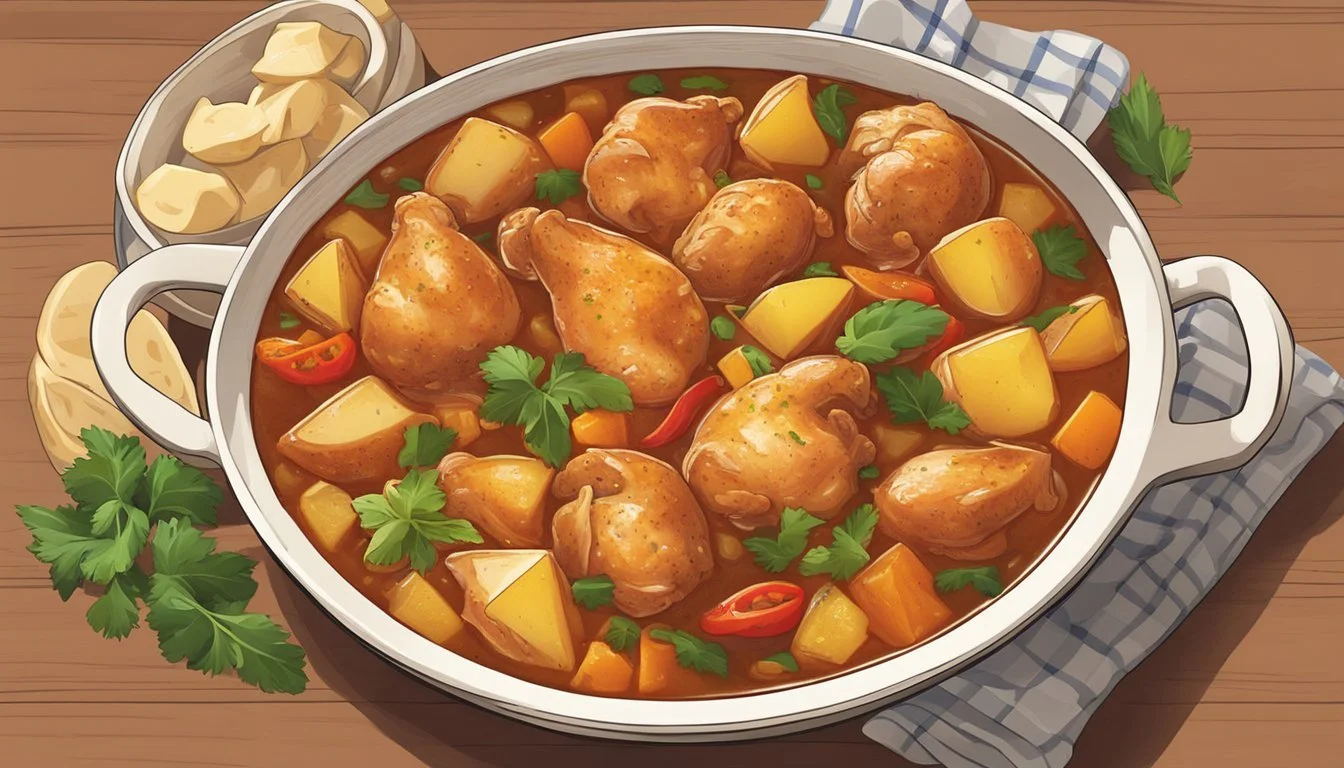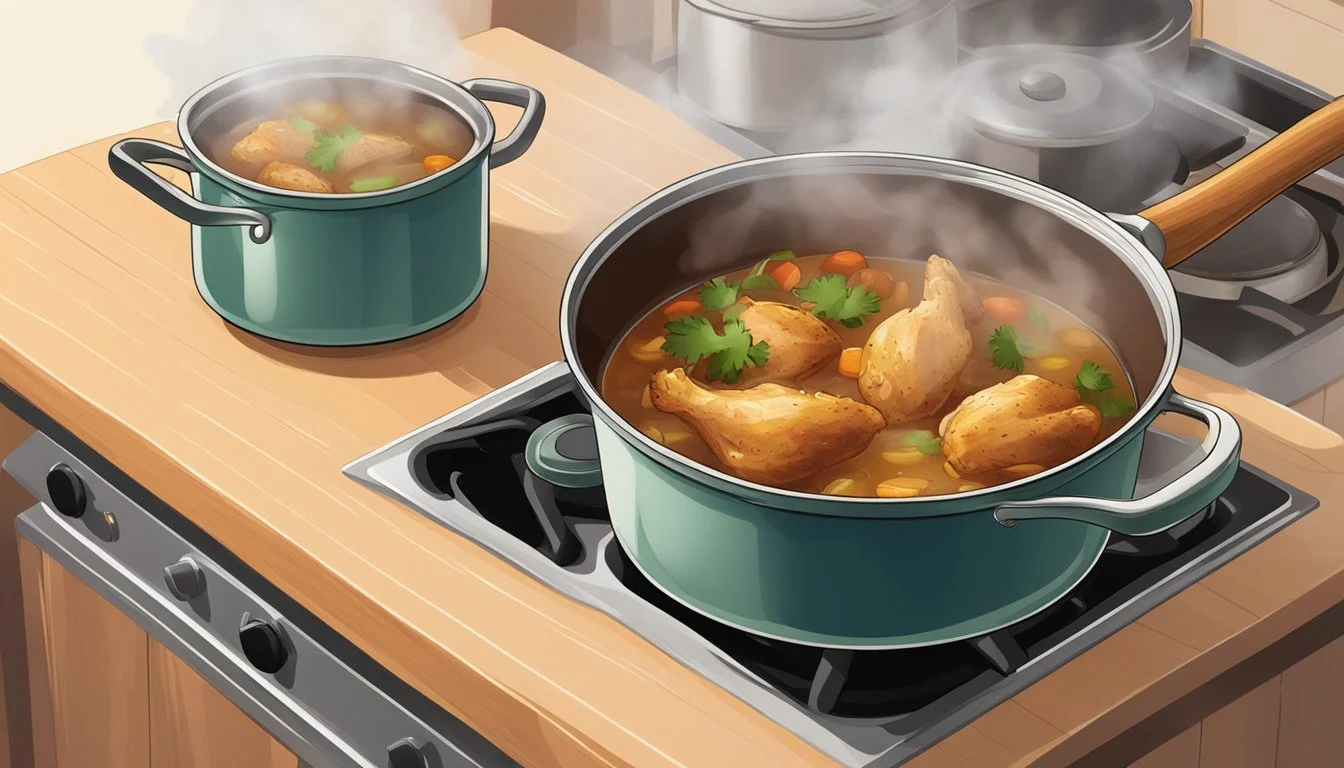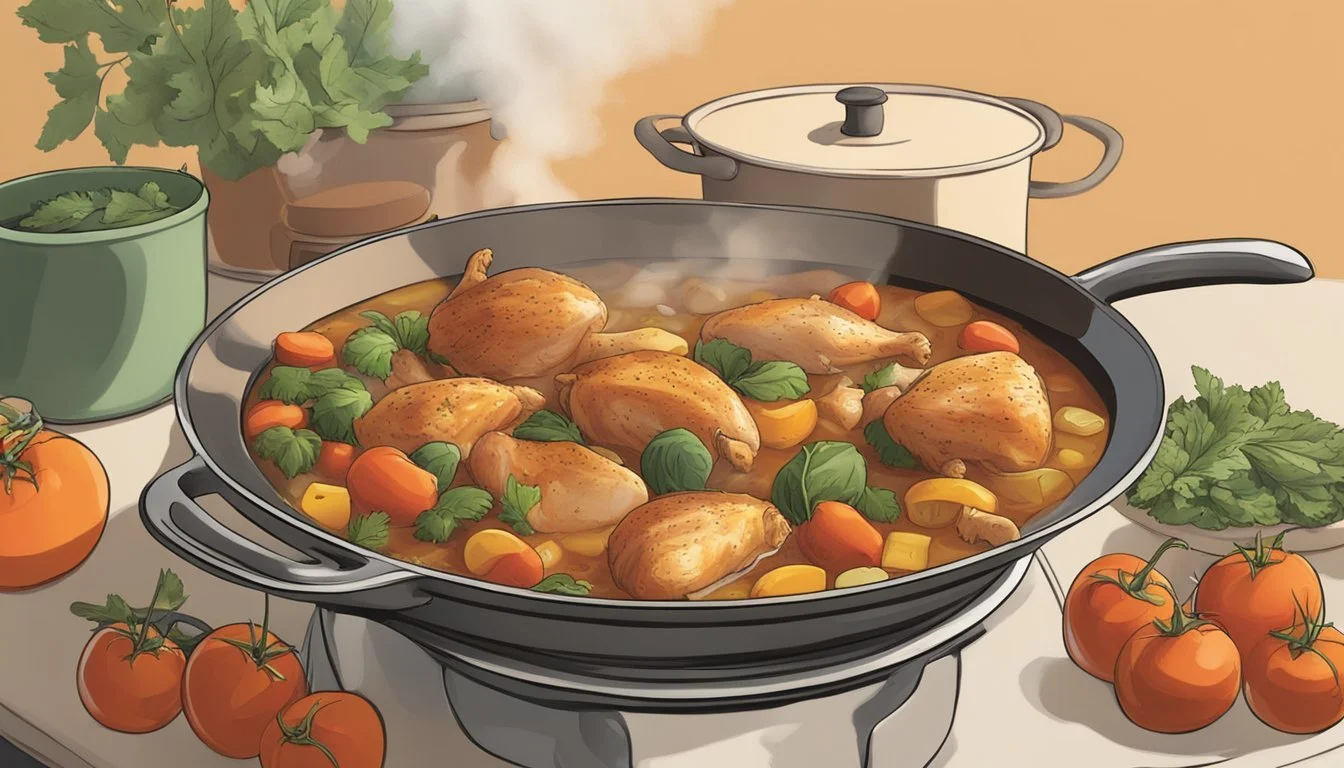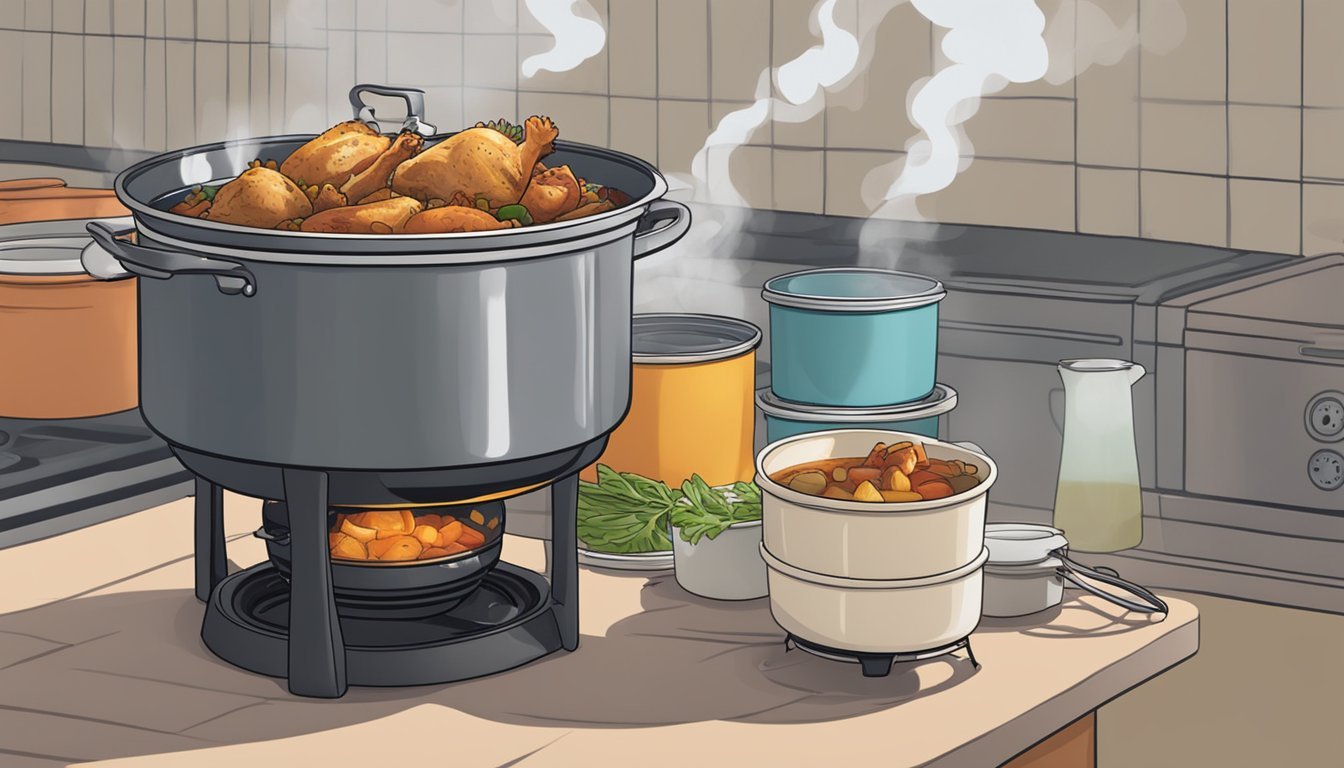How to Reheat Basque Chicken Stew:
Simple Steps for Perfect Results
Reheating Basque Chicken Stew, or Poulet Basquaise, can be an excellent way to enjoy the rich flavors of this traditional French dish again. Originating from the Basque region of France, this stew combines chicken, bell peppers, tomatoes, and onions in a delectable sauce that intensifies with time. To preserve its flavor and ensure it's safe to eat, the stew must reach an internal temperature of 165°F when reheated.
Microwaving is a convenient method for reheating, though it requires care and precision. Using short intervals and stirring periodically helps maintain the moisture and even heating of the stew. For those who prefer stovetop reheating, adding a bit of water or stock and gently warming the stew over medium heat can bring out its original taste and texture.
Sous vide enthusiasts might find their method ideal for reheating Poulet Basquaise, as it can rejuvenate the stew without overcooking the chicken or breaking down the vegetables. This immersion technique ensures uniform heating, making the stew as delightful as when it was first prepared.
Understanding Basque Chicken Stew
Basque Chicken Stew, known for its rich flavors and hearty ingredients, is a comforting dish influenced by French and Spanish culinary traditions.
The chicken used can vary, but chicken thighs and chicken legs are common choices due to their tenderness and flavor. These pieces are typically browned in olive oil before being stewed.
Essential vegetables include onions, tomatoes, and garlic. These ingredients are sautéed to bring out their natural sweetness and meld the flavors seamlessly.
Peppers are also crucial. Both green and red peppers are often included, adding color and depth.
Spices and herbs are vital. Paprika, thyme, bay leaf, and the aromatic piment d’Espelette lend their unique flavors. Piperade, a Basque pepper sauce, might also be added for more intensity.
Salt is used judiciously to enhance these flavors. All these ingredients are slowly simmered, allowing the flavors to meld harmoniously.
This stew showcases the essence of Basque cuisine and highlights the balance between simple ingredients and complex flavors.
Preparation Before Reheating
When preparing to reheat Basque chicken stew, proper storage is crucial to maintaining its quality. Leftovers should be placed in airtight containers to prevent bacterial growth.
Store the stew in the refrigerator within two hours of cooking. This helps to keep it safe for later consumption.
If you plan to reheat the stew, ensure it's not left at room temperature for extended periods.
It's important to check the stew's condition before reheating. Look for any signs of spoilage, such as an off smell or unusual texture.
Always transfer the stew from large containers to smaller, single-serving portions if you only need to reheat a bit at a time.
Following these steps will help ensure that the Basque chicken stew remains delicious and safe to eat.
Reheating Methods Overview
Reheating Basque Chicken Stew ensures the flavors and textures remain consistent. Key methods include using an oven, stovetop, microwave, and slow cooker, each offering unique advantages for maintaining temperature and consistency.
Reheating in the Oven
Preheat the oven to 350°F (175°C) for best results. Place the Basque chicken stew in an oven-safe dish, adding a small amount of water or chicken stock to prevent drying.
Cover with aluminum foil to maintain moisture and promote even heat distribution. Heat for 20-30 minutes, ensuring the internal temperature reaches 165°F (74°C) using a food thermometer.
Stir occasionally to enhance heat distribution and achieve a consistent texture. This method is ideal for reheating large batches, maintaining the stew's rich flavors and hearty consistency.
Stovetop Reheating
Use a frying pan or a medium-sized saucepan for stovetop reheating. Add the Basque chicken stew along with a splash of water or chicken stock to keep it from drying out.
Heat the stew over medium heat, stirring occasionally to distribute the warmth and maintain consistency. Simmer for 10-15 minutes, ensuring it reaches an internal temperature of 165°F (74°C).
Frequent stirring helps prevent sticking and burning, providing a smooth and even heat distribution. This method is practical for reheating smaller portions and allows for easy adjustment of moisture levels.
Microwave Reheating
Transfer a single portion of the stew to a microwave-safe bowl. Add one or two tablespoons of water or stock to keep the dish moist. Cover the bowl with a lid, vented plastic wrap, or a damp paper towel.
Microwave on medium-high power for one minute intervals, stirring in between each interval. Continue this process until the stew is evenly heated to an internal temperature of 165°F (74°C).
Microwave reheating is quick and convenient, particularly for single servings, but requires careful monitoring to avoid overcooking and drying out the stew.
Using a Slow Cooker
Place the Basque chicken stew into a slow cooker, adding a few tablespoons of water to prevent drying out. Set the slow cooker to medium heat and cover with a lid.
Allow it to reheat for 1-3 hours, stirring occasionally to ensure even heat distribution and prevent the stew from sticking to the sides.
Once heated, it can be kept on a low setting until ready to serve. This method retains the stew's flavors and consistency, though it requires more time for reheating. Ideal for reheating large quantities without constant supervision.
Adjusting Texture and Flavor
To achieve the desired consistency in Basque Chicken Stew, consider the following techniques.
Add cornstarch mixed with cold water to thicken the stew. Use one tablespoon of cornstarch per cup of liquid. Stir the mixture before adding to the stew and cook for a few minutes until thickened.
For better flavor enhancement, incorporate stock or wine. Replace some of the liquid with chicken stock for richer taste. A splash of white wine can also elevate the stew's depth.
Use olive oil to sauté onions and garlic before reheating. This can refresh and intensify the flavors. If the stew tastes flat, sprinkle some salt and pepper to taste during reheating.
Consider adding fresh spices like paprika, thyme, or bay leaves. Freshly ground pepper and a pinch of salt can revitalize the stew.
If the stew feels too dry, add more liquid such as stock or water. Conversely, if it seems too watery, simmer it longer to reduce the liquid. Adjust seasonings after achieving the correct consistency.
Finally, balance acidity with a small amount of vinegar or lemon juice to brighten flavors. Add these cautiously, a little at a time, and taste as you go.
Additional Ingredients & Enhancements
Enhancing Basque Chicken Stew with additional ingredients can elevate its flavors and nutritional value. Integrating vegetables, proteins, and adjusting spices and herbs are key areas to focus on.
Incorporating Vegetables
Vegetables can add both texture and flavor to Basque Chicken Stew. Potatoes are a traditional addition, providing a hearty base that absorbs the stew's juices well. Cutting them into small, even pieces ensures they cook evenly.
Adding bell peppers, particularly red and green varieties, imparts sweetness and a subtle crunch. Onions can enhance the aromatic profile, while garlic brings a pungent depth.
Consider adding carrots for natural sweetness and zucchini for a fresh bite. Tomatoes can add acidity, balance flavors, and increase liquid content. A handful of spinach or kale at the end of cooking incorporates additional nutrients and a vibrant look.
Adding Proteins
While chicken is the primary protein in Basque Chicken Stew, diversifying the meat can enrich the dish's complexity. Chicken breast or boneless, skinless thighs offer leaner options that cook quickly and absorb the stew's flavors.
Chorizo is a popular addition, providing a smoky richness and a hint of spice, complementing the existing flavors. For a seafood twist, shrimp or clams can infuse the stew with unique, briny notes.
If considering vegetarian alternatives, white beans or chickpeas can substitute meat while adding protein and a creamy texture. They also absorb the stew's spices and provide a hearty bite.
Adjusting Spices and Herbs
Tweaking spices and herbs tailors the stew to specific tastes. Thyme and bay leaves are classic choices, imparting earthy undertones. Adding these early in the cooking process helps their flavors meld into the stew.
Fresh parsley used as a garnish adds a burst of color and a fresh finish. Smoked paprika brings a deep smokiness that elevates the stew's profile and works well with the chicken and chorizo.
For those preferring a kick, chili powder or shredded fresh chili peppers can be added in moderation. These spices should be balanced with caution to avoid overpowering the dish. Incorporating a dash of lemon juice or zest towards the end brightens flavors and balances the stew's richness.
Food Safety Considerations
Maintaining food safety when reheating Basque Chicken Stew is essential to prevent bacterial growth and ensure the dish remains safe to eat.
Temperature Control: Leftovers must be reheated to an internal temperature of at least 165°F (74°C). Using a food thermometer is recommended to verify that the entire stew reaches this temperature.
Microwave Reheating: When using a microwave, heat the stew in short intervals and stir periodically. This ensures even heating and prevents cold spots where bacteria might survive.
Storage: Refrigerate the stew promptly after cooking. Store in an airtight container to minimize exposure to air and contaminants.
Reheating Multiple Times: Limit reheating chicken stew to only once. Repeated reheating can diminish taste and increase the risk of foodborne illnesses.
Preventing Bacterial Growth: After reheating, ensure any leftovers are kept above 135°F (57°C) if held for serving. Avoid leaving the reheated stew at room temperature for more than two hours.
Best Practices:
Cover the stew when reheating, whether using a microwave or stovetop.
Stir the stew to distribute heat evenly.
Allow the stew to stand covered for a few minutes post-reheating to let the heat continue to distribute.
Following these guidelines will help maintain the flavor and safety of your Basque Chicken Stew.
Storing Leftovers
When storing Basque chicken stew, ensure it cools to room temperature within two hours. This prevents bacterial growth and maintains food safety.
Transfer the stew to shallow containers to speed up cooling. This helps reduce the risk of harmful bacteria. Airtight containers are ideal for keeping the stew fresh and preventing spills.
For refrigeration, place the sealed containers in the fridge. Leftovers can safely be stored in the fridge for up to three days.
To freeze the stew for longer storage, use freezer-safe airtight containers or heavy-duty freezer bags. Freezer burn can be minimized by removing as much air as possible before sealing.
Label containers with the date before storing them in the freezer. This makes it easy to keep track of the stew's storage time.
Frozen stew can be kept for up to three months. Thaw it in the refrigerator before reheating for the best texture and flavor.
Serving Suggestions
Basque Chicken Stew pairs wonderfully with a variety of side dishes that enhance its rich flavors.
Rice: Serve the stew over a bed of fluffy white or brown rice. The rice soaks up the savory sauce, providing a satisfying base.
Crusty Bread: Accompany the stew with slices of crusty bread. The bread is perfect for dipping and ensures you enjoy every drop of the delicious sauce.
Parsley: Garnish with freshly chopped parsley. This addition adds a bright, fresh note that complements the stew’s deep flavors.
They can also consider a simple green salad. The salad provides a crisp and refreshing contrast.
For those who enjoy a bit of spice, a few dashes of hot sauce can heighten the flavors.
Together, these sides and garnishes provide a balanced and complete meal.
Nutritional Information
Basque Chicken Stew offers a well-rounded mix of nutrients. This dish typically contains chicken, potatoes, bell peppers, and tomatoes.
Calories
A serving of Basque Chicken Stew provides approximately 300-400 calories. The exact number may vary based on the recipe and portion size.
Proteins
Chicken, the primary protein source, offers around 20-25 grams of protein per serving which aids in muscle repair and growth.
Fats
The stew generally contains 10-15 grams of fat per serving. Most of this comes from chicken skin and cooking oil. Opt for skinless chicken to reduce the fat content.
Carbohydrates
With potatoes and vegetables, one serving of Basque Chicken Stew typically has 30-40 grams of carbohydrates. These provide essential energy.
Fiber
This meal provides 4-6 grams of dietary fiber, contributing to digestive health.
Sodium
Depending on added salt and broth used, sodium content can range from 600-800 milligrams per serving. To manage sodium intake, use low-sodium broth and minimize added salt.
Vitamins and Minerals
Rich in vitamin C from bell peppers and tomatoes and B vitamins from chicken. Contains minerals such as potassium from potatoes and iron from chicken and vegetables.
Here’s a quick look at the nutritional breakdown per serving:
Nutrient Amount Per Serving % Daily Value* Calories 300-400 N/A Protein 20-25g 40-50% Fat 10-15g 15-20% Carbohydrates 30-40g 10-13% Fiber 4-6g 16-24% Sodium 600-800mg 25-35%
*Percent Daily Values are based on a 2,000 calorie diet.
This table helps highlight key nutritional information, making it easier to see what's in each serving and its contribution to a balanced diet.








